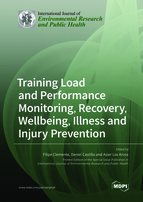Training Load and Performance Monitoring, Recovery, Wellbeing, Illness and Injury Prevention
A special issue of International Journal of Environmental Research and Public Health (ISSN 1660-4601). This special issue belongs to the section "Health Behavior, Chronic Disease and Health Promotion".
Deadline for manuscript submissions: closed (31 August 2021) | Viewed by 59260
Special Issue Editors
Interests: football; soccer; match analysis; performance analysis; network analysis
Special Issues, Collections and Topics in MDPI journals
Interests: physical performance; external loads; training-related fatigue; match load monitoring; contextual factors; sports injuries; team sports
Special Issues, Collections and Topics in MDPI journals
Interests: team sports; sport pedagogy; tactical behavior; electronic performance and tracking systems
Special Issues, Collections and Topics in MDPI journals
Special Issue Information
Dear Colleagues,
A growing body of literature demonstrates the importance of establishing a well-implemented player monitoring cycle in order to optimize the training process and improve performance. Such tools enable coaches and sports scientists to track the development of players and athletes across the season; help minimize injuries, risk factors and illnesses; and increase player readiness for competitive events. Naturally, the multifactorial dimension of performance requires a holistic point of view to establish a well-connected relationship between the training process and the load associated, the impact on the player’s recovery, and the consequences of acute and chronic responses. Moreover, it is also important to determine how the physical status of a player may interfere with recovery and management of load. Despite an important understanding of how those factors interact, commonly, the research splits the analysis, not allowing a multivariate interpretation of how load, recovery, and physical status contribute to performance or, on the other side, to explain possible illness or injuries. Thus, it is important to enact additional epidemiological studies to identify the determinants of injuries and illness in athletes. Such studies would both increase performance opportunities and reduce the possibility of alarming symptoms, decreased performance, or long hiatuses in performance due to injuries/illness. As many athletes and players are amateurs or play recreationally without oversight by sport science departments or coaches, it is necessary to monitor their training in order to minimize the risk factors leading to injuries and illness as a question of public health.
Considering that more research should be done and published on such important topics, the aim of this Special Issue on “Training Load and Performance Monitoring, Recovery, Wellbeing, Illness and Injury Prevention” is to publish high-quality original investigations, narrative and systematic reviews in the field of training process, dose–response relationships, training load monitoring, recovery strategies, illness, and injuries. We look forward to receiving contributions related (but not limited) to the following topics: (i) strength and conditioning programs for injury prevention or return to play; (ii) training load monitoring and dose–response relationships; (iii) physical status and its impact on performance, recovery or injury risk; (iv) recovery strategies and their impact on readiness and performance; and (v) determinants of injury risk and illness in elite, professional, and recreational athletes. We would welcome papers related to evidence of successful intervention strategies. All manuscripts will be peer-reviewed by experts in the field.
Dr. Filipe Manuel Clemente
Dr. Daniel Castillo
Dr. Asier Los Arcos
Guest Editors
Manuscript Submission Information
Manuscripts should be submitted online at www.mdpi.com by registering and logging in to this website. Once you are registered, click here to go to the submission form. Manuscripts can be submitted until the deadline. All submissions that pass pre-check are peer-reviewed. Accepted papers will be published continuously in the journal (as soon as accepted) and will be listed together on the special issue website. Research articles, review articles as well as short communications are invited. For planned papers, a title and short abstract (about 100 words) can be sent to the Editorial Office for announcement on this website.
Submitted manuscripts should not have been published previously, nor be under consideration for publication elsewhere (except conference proceedings papers). All manuscripts are thoroughly refereed through a single-blind peer-review process. A guide for authors and other relevant information for submission of manuscripts is available on the Instructions for Authors page. International Journal of Environmental Research and Public Health is an international peer-reviewed open access monthly journal published by MDPI.
Please visit the Instructions for Authors page before submitting a manuscript. The Article Processing Charge (APC) for publication in this open access journal is 2500 CHF (Swiss Francs). Submitted papers should be well formatted and use good English. Authors may use MDPI's English editing service prior to publication or during author revisions.
Keywords
- training load
- dose–response relationship
- sports performance
- injury prevention
- recovery strategies
- fatigue
- fitness status
- strength and conditioning
- return to play
- wellbeing
- sports medicine and health








